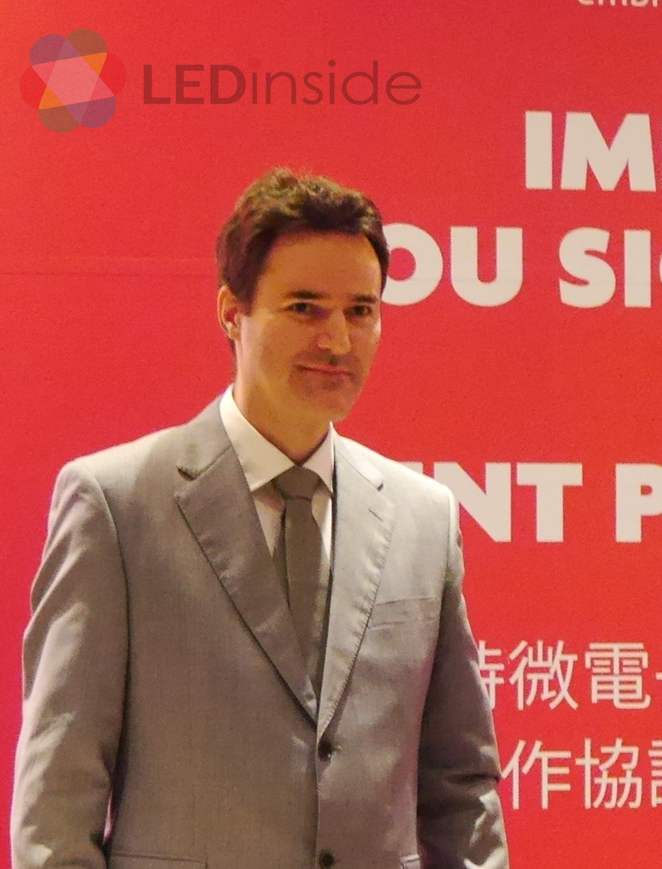imec as a world-leading R&D center and innovation hub in nanoelectronics and digital technology has been dedicated to using the power of technology to improve lives. The institute has gathered researchers from around the world to transform conceptual ideas into solid solutions to tackle real world problems. imec has also been extending its collaboration with international partners and has set up its first R&D center outside Europe in Hsinchu, Taiwan, ten years ago.
LEDinside was delighted to interview Peter Lemmens, Managing Director of imec Taiwan, to get a grasp of his insight about the current development of Micro LED technology.

Lemmens first discussed the vision of imec in Micro LED development. He noted that they are aware of the mature environment of semiconductor manufacturing in Taiwan and thought about how to utilize these sophisticated technologies and facilities to develop innovative applications. Micro LED was one of the approaches that are viable.
With its feasible technologies, imec has developed Conformal Structure Method (CSM) using a spring structure to transfer Micro LEDs onto different substrates. With the method, LEDs can be transferred and the pitches between them can be adjusted within the same process. imec utilizes monocrystalline silicon or Copper microsprings of 3.5-5 μm wide to repeatedly transfer Micro LEDs while stretching the spacing between numerous Micro LEDs in two directions for fitting various applications in a single movement. Head-up Display, for example, requires high transparency and thus the pitches between LEDs need to be in a certain distance.
However, as Micro LEDs are very small and the transferring amount is very big, imec is still working on improving the positioning accuracy in order to achieve the desired optical and visual performance. One issue is that they need to have equipment with high precision to make sure the distance between each LEDs is identical. The tolerance is only between 10-20 μm, which is extremely difficult to achieve, Lemmens pointed out. Moreover, as the transfer matrix includes numerous LEDs, it is challenging to control all the microsprings to stretch and contract in the same way. Most of the available equipment was not made to achieve the precision of the level required by Micro LED. Applying techniques and equipment for semiconductor production can be a way to solve the issue, as they are designed to meet higher precision requirement.
In order to bring technologies including Micro LED from the laboratories to the industry, corresponding equipment is necessary. It was reported in July that imec would be collaborating with Marketech International Corp. (MIC), a Taiwan-based semiconductor equipment supplier for developing a testing chip implantation equipment for Micro LED manufacturing. Lemmens indicated that imec has been constantly working with major equipment producers worldwide. Through leveraging the strengths from imec and the equipment makers, they aim to design various kinds of equipment to realize innovative applications. For Micro LED production, it has been challenging for imec to bring the micrometer standards from the semiconductor industry to the millimeter-standard equipment industry.
Speaking of the development timeline for the equipment, Lemmens underlined that the first prototype machine has been built five years ago and pilot experiments have been conducted since then. However, the final stage of the production is the most difficult part and imec is still working on improving yield. Once imec completes the technology section, their client will take over and modify according to their needs; it is therefore hard to tell when the Micro LED equipment will be released. From the perspective of imec, it might take two more years for them to improve and tackle difficulties before passing the equipment to their clients. However, what imec has focused the most is how to solve challenges for different applications.
imec has explored diverse application areas with technologies. The collaboration between imec Taiwan and Instrument Technology Research Center of National Applied Research Laboratories (ITRC-NARLabs) is an approach to broaden the application possibilities by integrating the strengths from both organizations. For Micro LED applications, Lemmens mentioned four areas: displays, wearables, human machine interface and industrial applications.
Lemmens illustrated how Micro LED can be applied for human machine interface to improve the service and enhance convenience. By embedding both Micro LEDs and small sensors onto signage or other boards, functions such as touch interaction or temperature measurements can be increased in different places with lower cost as touch panel is not required. These kinds of applications can be integrated with cars or other machines.
Another potential application is in the industry, said Lemmens. As many lighting producers worldwide have changed their focus from selling luminaires to selling lighting as services, Micro LED applications can bring the trend a step further. Lighting services can be integrated with curing or sterilizing by combining LEDs of different functions, for example. Lemmens also noted that Micro LED chips can be integrated with textile as they are very small to create clothes with lighting and sensing functions for industrial applications.
Taiwan has been an important center for imec’s researches on Micro LED applications. imec has also been working with universities in Taiwan and Europe with the goal of finding out how Micro LED can be bonded with different materials and in different ways. Through its research, imec is looking forward to developing even more applications with Micro LED, concluded Lemmens.





 CN
TW
EN
CN
TW
EN






